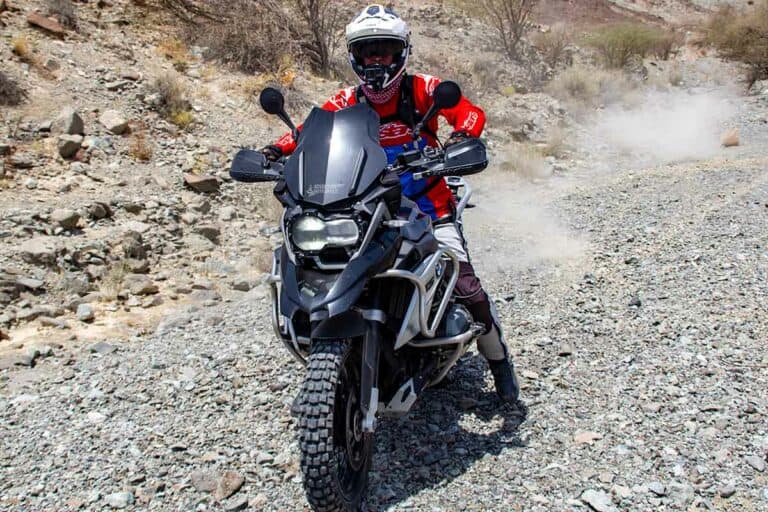ADV Motorcycle Dropping Fears – FAQs from riders
There is an old saying in the motorcycle community: “Keep the shiny side up and the rubber side down”. Fear of dropping one’s bike is understandable … we’ve all been there. This is especially true when riding off-road on terrain that is unfamiliar or challenging. In this article, we will dissect some of the most common questions and fears that adventure motorcycle riders have about dropping their bikes and offer actionable solutions.
Motorcycle riders frequently ask how to overcome their fear of dropping their bike. Top fears include damaging a new bike, injuring themselves, and feeling unprepared. To move past these fears, riders must understand why drops happen and know how to manage the situation when it arises.
As a former Harley rider, the idea of regularly dropping my bike during off-road adventure riding was a paradigm shift for me. As a kid, I was no stranger to tumbling off my skateboard or BMX bicycle, but the idea of dropping a 550lb / 250kg machine out on a gravel road was somehow different. I had all of the same questions then, that my coaching clients have for me now. Let’s dive into these issues and learn how to get past the fear and start enjoying the adventure.
This post may contain Affiliate Links. Please see our Privacy & Disclosure Policy for more details.
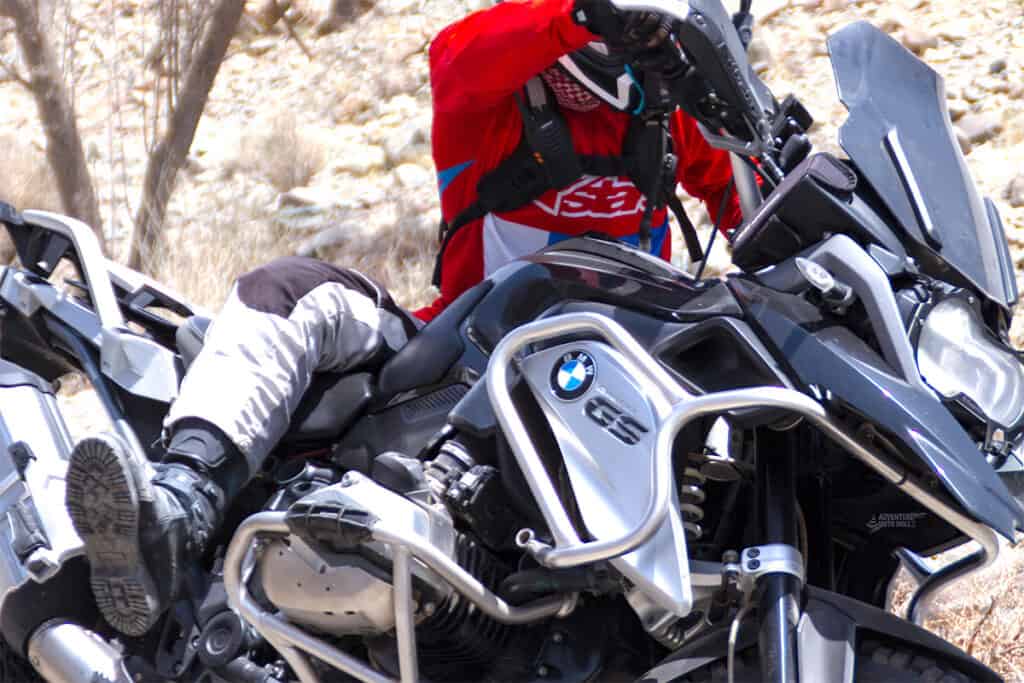
Why does the motorcycle drop?
The first step to overcoming the fear of dropping the bike is to better understand why it happens. Off-road adventure motorcycle riding will include tip-overs, drops, and falls … it is just part of the sport. But it is within our control to limit these drops by proactively addressing the most common causes.
Motorcycles drop off-road due to loss of balance or loss of traction
So let’s take a look at the factors that contribute to both balance and traction:
| VISION | One of the top reasons for dropping the bike is the failure to look ahead to where you want to go. Back roads and off-road trails offer many distractions such as rocks and roots on the ground or beautiful scenery and vistas. The bike will go wherever you keep your focus so be sure to choose wisely. Our YouTube vision video is here. |
| MOMENTUM | Off-road riding is slower than highway riding with a lot of 1st & 2nd gear sections. But if that is coupled with a lack of consistent momentum, the bike will have a hard time staying upright. The key to steady momentum is proper throttle-clutch-brake balance. |
| LEAN ANGLE | Off-road cornering is not the same as on-road technique. Typically cornering off-road, the bike should lean into the corner while the rider leans to the outside to counterbalance. These lower traction surfaces found off-road coupled with excessive lean angle can cause the tires to lose grip resulting in a fall. |
| LINE SELECTION | Off-road riding is a little like a game of chess. We need to be thinking 3 or 4 steps ahead and chose our line of travel wisely. Proper line selection ensures we avoid hazards and set ourselves up for success further down the trail. Lack of proper line planning can lead to emergency stop scenarios or worse. |
| CONFIDENCE | If you have yet to build up confidence in yourself and your riding abilities, then the best course of action is to hire a coach. Group training opportunities are a great way to learn some skills and receive encouragement from other riders. Private coaching focuses 100% on your needs and learning the exact techniques to help you reach your riding goals. |
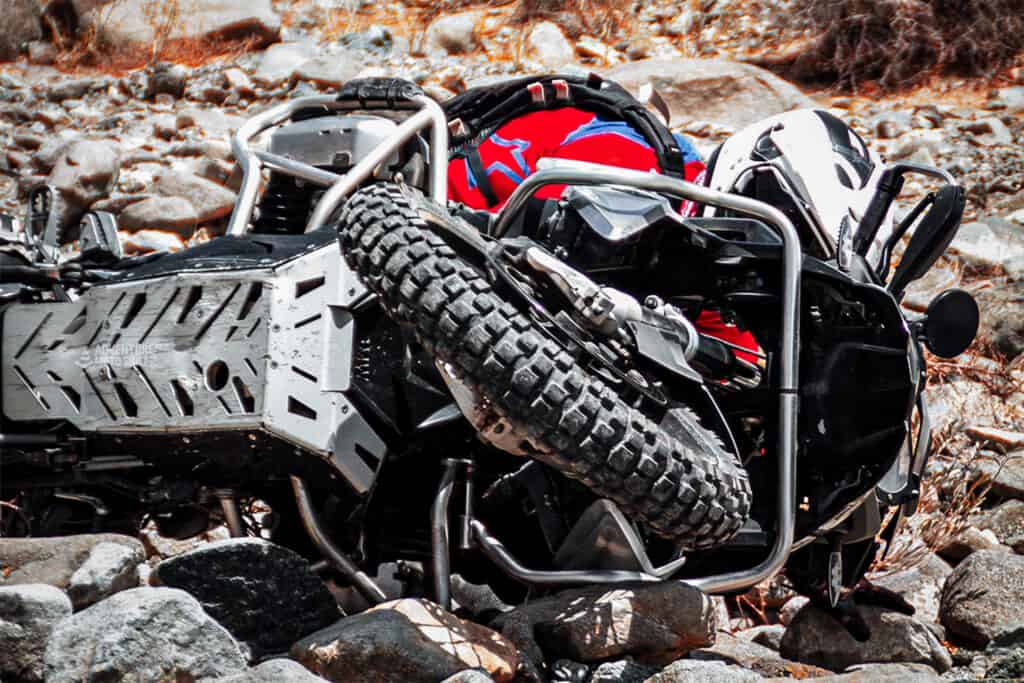
But even with the best of intentions, sometimes the trail simply gets the better of us!
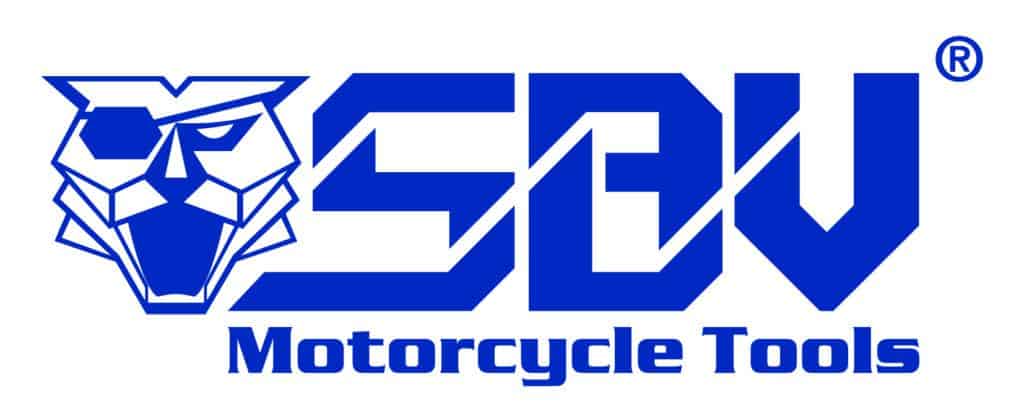
Innovative Motorcycle Tool Sets – Compact & Reliable
Used and recommended by ADVMotoSkillZ
Does everyone drop their bikes off-road?
Dropping the bike is an inevitable part of this sport and it can happen to anyone at any time. Experience may lessen the frequency of drops, but veteran riders have to deal with this on any given ride as well. If you’re new to riding, or if you’re thinking about getting into it, here are a few things you should know about dropping your motorcycle.
- Don’t panic when the bike goes down
- After a tip-over, turn your bike off straight away
- Take a moment to ensure you are okay
- In time, lift the bike and see if there was any damage
- If your riding partners saw you fall, then have a good laugh together
- Ego has no place in ADV riding, the drops will happen
- Learn from the experience and you just may succeed next time
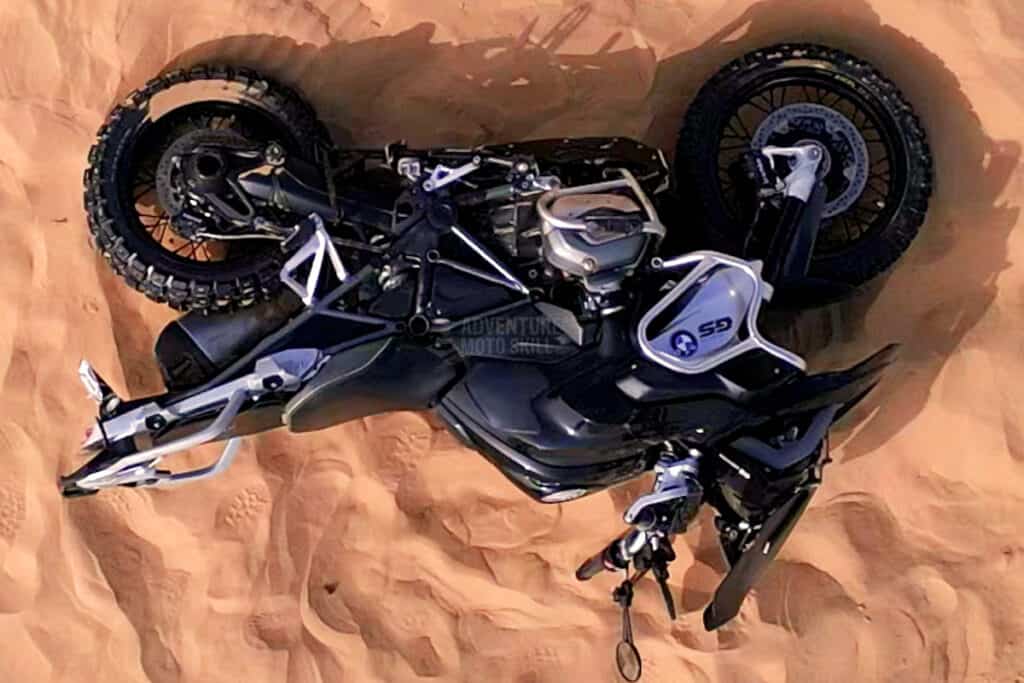
How much damage can I cause to my bike if I drop it?
ADV bikes are built with adventure in mind, so they can take a fair bit of abuse without any mechanical damage. Protective kit such as engine guards, radiator covers, skid plates & hand guards creates a protective layer around the bike that keeps your bike injury-free in most tip-overs. Mechanical damage to an off-road bike is much more likely to occur from poor rider inputs (such as improper shifting techniques or over throttling from a stuck position) as opposed to from a fall.
Cosmetic damage is much more common during a tip-over onto rocks or gravel than any mechanical damage. Scratched paint, a bent lever, or a broken indicator are common for technical off-road trail riding. Although it is heartbreaking to get those first scratches on a bike, it’s best to see them as tokens of experience. Each mark you put on the bike will tell a story of a new lesson learned.
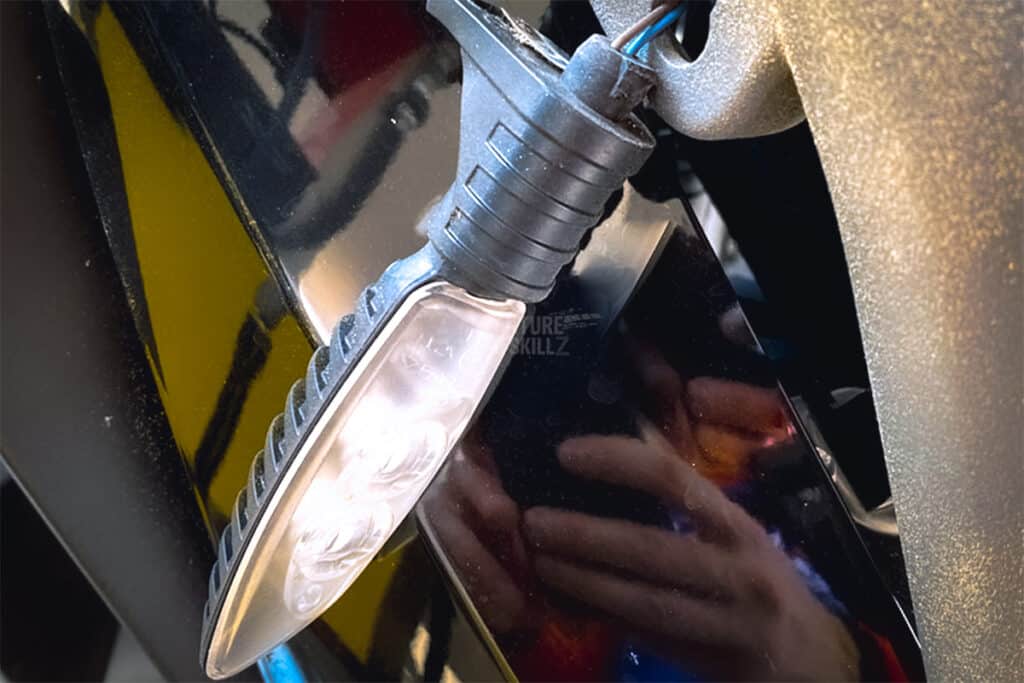
Can I injure myself if the motorcycle drops or tips off-road?
To be clear, this post is discussing typical off-road drops, tips, and falls that occur either when stationary or when traveling in 1st & 2nd gear. We are not referring to proper motorcycle crashes when traveling over 30mph / 48 kph and running into trees. That being said, it is possible to injure yourself, even on a slow and simple tip-over, if you are unprepared.
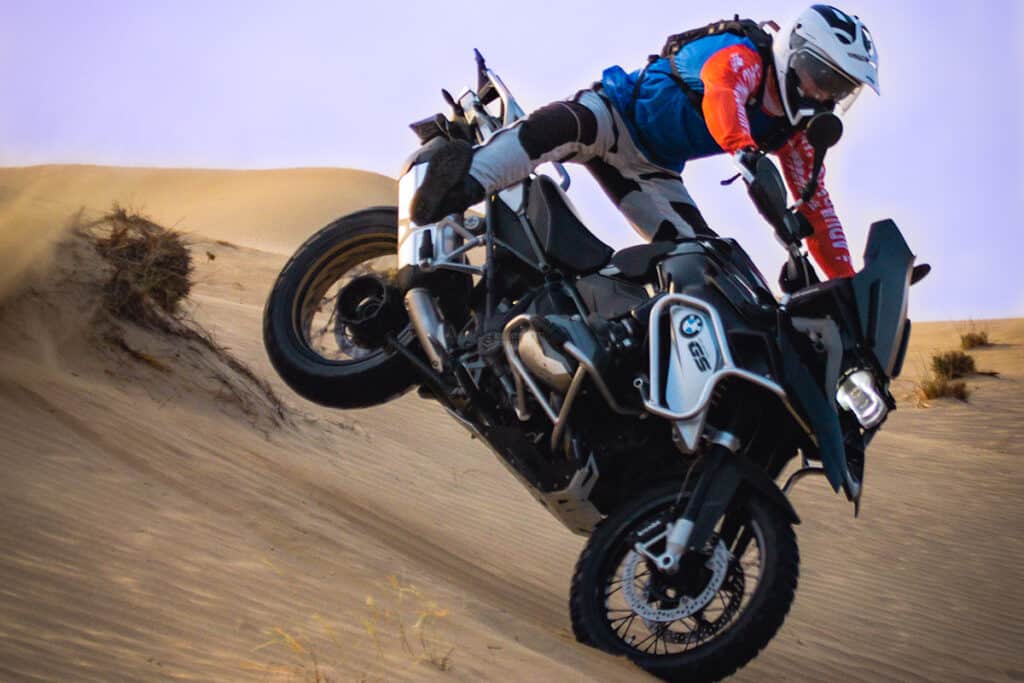
If you have the opportunity to watch a judo tournament, you can see a group of athletes who are experts at falling safely. They are prepared mentally for the possibility that their opponent will throw them, and have drilled proper falling techniques to the point that it is in their muscle memory. They get thrown, they fall, and they get up to play on for another point.
If we apply these principles to adventure motorcycle riding, we can have the same success. We achieve this by first accepting that the fall or tip is possible … we are mentally prepared for the fact that the moment we lose balance or traction, we are at risk of going down. We learn safe falling techniques that help us to avoid common injuries such as a fracture from a fall onto an outstretched arm or FOOSH injury. (learn about FOOSH injury from WedMD here)
Secondly, we learn and drill proper techniques for tips and drops that keep us safe from injury. Learning the balance point of your bike is essential and we review some great balance drills in this post for you to practice first. When you are in sync with your bike’s balance point it is easier to know when it has crossed its tipping point and is going down.
Tips on how to safely drop the bike to avoid personal injury:
- Never try to “save” a bike from going down if it is past its tipping point. Trying to muscle up a falling 550lb/250kg bike while riding it can quickly lead to a back injury, twisted knee, or shoulder strain. No matter your age or fitness level, it is never a good idea to try to override a big, heavy bike on its way down.
- At the moment you recognize that the bike has gone past the point of no return, fully pull in the clutch lever and quickly look at the ground where the bike will be landing to make your plan (this is just like line selection planning, but is actually tip-over planning).
- If the bike is tipping to the left side, step your left leg out, as wide as you can safely step, to create an open space of ground under you where the bike can land. Depending on your speed, you may end up taking a couple of hops on the left foot as the bike comes to a stop
- As the bike falls to the ground, lift your right leg up and step safely to the left side of the bike
- Kill the bike’s engine as quickly as possible because the fluids can not properly circulate with the bike down
Watch an example here:
By mentally accepting that the fall is about to happen and physically positioning ourselves clear of the bike’s falling trajectory, we significantly reduce the likelihood of personal injury.
Failure to get yourself into a safe position and/or staying on the bike as it falls puts you at risk of having the bike land on your inside leg or receiving injury from the ground itself. Even the most complete set of protective gear can not eliminate injury in all circumstances. For example, you may be wearing hard enduro boots but a hard fall on a rock with the bike landing on your lower leg may still result in a leg or ankle fracture.
I am not raising these warnings to scare anyone, instead, they are highlighted as realities to prepare and practice for so you feel confident once out on the trails. Learn these techniques for safe bike falls to reduce potential injury during the event. Next, we discuss how to recover after the fall happens to also protect yourselves & the bikes.
ALL THE GEAR ALL THE TIME

Top-quality gear for your next adventure
Used and recommended by ADVMotoSkillZ
How do I recover after a dropped or tipped bike happens?
Once the bike is down and the engine is off, take a moment for self-inspection and to get your breathing under control. If this was your first tip-over, then emotions will be higher than on your 100th fall. If you have any injuries, be sure to tend to yourself before all else.
Next, it’s time to up the bike. Reviewing all of the techniques for bike lifting is a topic for a separate post, but here are some common tips:
- If your riding partner is able to help you lift the bike, then most definitely accept the help. Deadlifting an adventure bike in full riding gear when hot & tired is far easier with 2 riders than on your own.
- Choose your line of travel before lifting the bike. It’s common for a fallen bike to be pointing in a different direction than the one you want to go. And it may be easier to spin the bike on the ground versus having to 180° turn it around once up.
- Scan your environment before lifting the bike to ensure both you and the bike will be safe once upright. If the bike had fallen on a hill, on single-track, or near water (as examples), then you may need to reposition the bike on the ground before lifting it.
- Once you have positioned the bike and lifted it with your preferred lifting technique, be sure to let your adventure bike rest for a few minutes before attempting to start it. No need to feel nervous if it doesn’t start straight away or puffs out a plume of white smoke once you do (it’s just oil burning off).
- Work with a coach to learn and practice all of the bike lifting techniques. There is more than one way to lift the bike and a good coach with both teach you the techniques, as well as educate you on when to use each one.
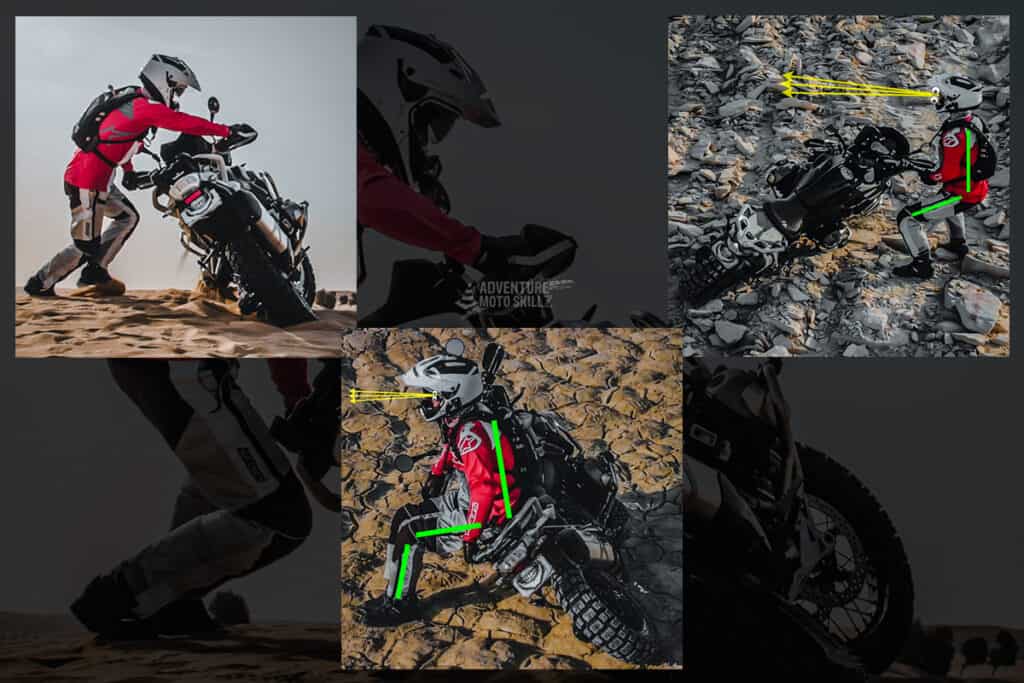
“I hear you, but I’m still scared of dropping my motorcycle” … How do I overcome my fear?
It is important to decide why you are scared in order to find the solution.
- Are you nervous to scratch the paint?
- Are you physically unfit and nervous about injuring yourself?
- Do you currently lack the skills to ride off-road?
- Do you doubt the quality of your protective riding gear?
- Is the thought of falling in front of your mates a bit too much to bare?
Whether your fear stems from any of these above or something completely different, the solution is to reach out for help. Talk to other experienced and trusted off-road adventure riders in your community. Take some lessons to improve your skills and talk through common falling bike scenarios. Find a coach that matches your personality and riding style, and who can guide you through these challenges and get you out for your next adventure.
Join our Instagram community or YouTube community to chat with other like-minded riders.
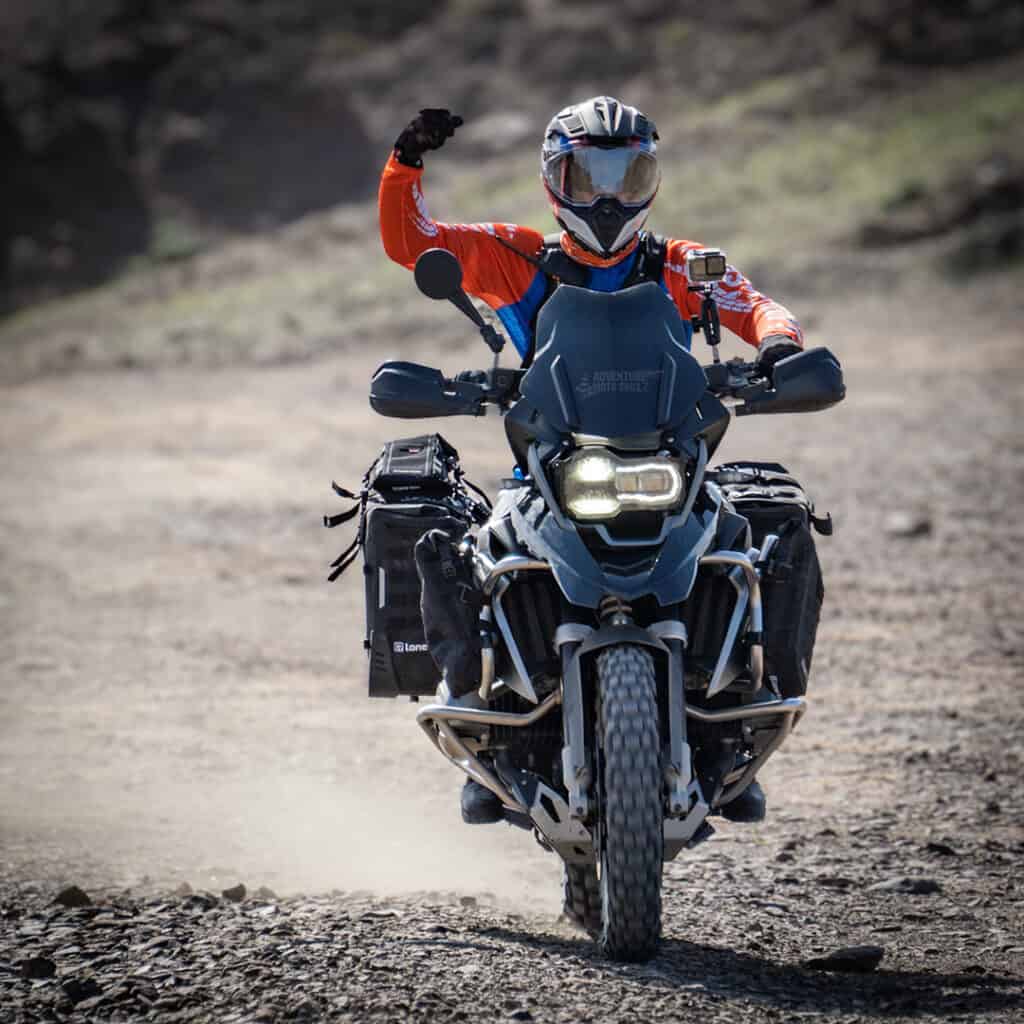
About the Author
Coach Mike is a Certified Off-Road Motorcycle Instructor & founder of ADVMotoSkillZ.
Riding tips from ADVMotoSkillZ reach thousands of international riders daily through social & blogs.
Click here to learn more about Mike’s motorcycle evolution from a Harley road rider to finding his true passion for off-road riding on a BMW 1200 GS.
If you would like to send Mike a quick message or invite him to provide training at your local facility, then visit the contact page here.

